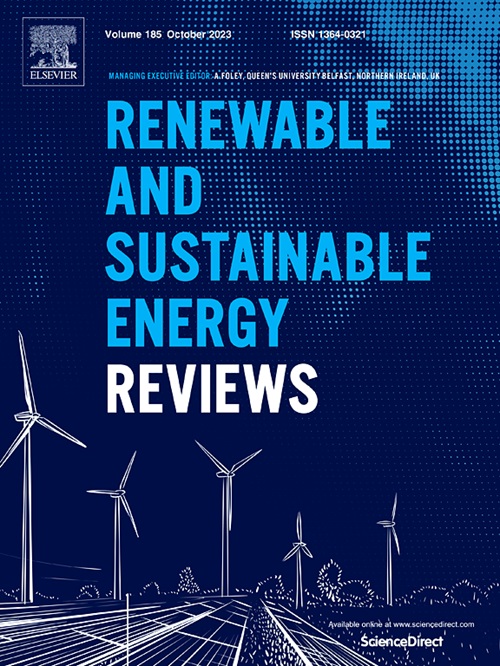Comparing sustainable fuel adoption in the energy transition for maritime and aviation transport
IF 16.3
1区 工程技术
Q1 ENERGY & FUELS
引用次数: 0
Abstract
Maritime and aviation transport are widely recognised as sectors where reducing greenhouse gas emissions is particularly challenging due to their reliance on energy-dense fuels and the challenges associated with direct electrification. These sectors face increasing pressure to defossilise and reduce emissions in line with global climate goals, while simultaneously facing unique technological, operational, and economic uncertainties. This study addresses a key research gap by comparing the maritime and aviation sectors for common factors and sector-specific differences in their transition to green e-fuels produced from renewable electricity and sustainable CO2. A techno-economic assessment is conducted to evaluate alternative fuel and propulsion options using the levelised cost of mobility framework. The analysis also incorporates the pricing of non-CO2 greenhouse gases and air pollutant emissions. Results show that e-ammonia or e-LNG combustion is the most cost-effective option for maritime transport, when emission costs are excluded, whereas hydrogen fuel cells become more economical when these costs are internalised. In aviation, e-kerosene use in conventional aircraft presents the lowest costs, regardless of the year or emission pricing. The findings highlight the importance of considering unique characteristics of each sector and tailored defossilisation and decarbonisation strategies that consider sector-specific constraints. To sustainably meet the growing demand for transport fuels, rapid investments in renewable electricity generation, electrolysers, and e-fuel synthesis are essential. Development of strong regulatory frameworks and financial instruments will be critical to support early deployment of e-fuels and minimise the risks.
比较海运和航空运输能源转型中可持续燃料的采用
海运和航空运输被广泛认为是减少温室气体排放尤其具有挑战性的行业,因为它们依赖于能源密集型燃料,以及与直接电气化相关的挑战。这些行业面临着越来越大的压力,需要按照全球气候目标去化石化和减排,同时也面临着独特的技术、运营和经济不确定性。本研究通过比较海事和航空部门向可再生电力和可持续二氧化碳生产的绿色电子燃料过渡的共同因素和部门具体差异,解决了一个关键的研究空白。技术经济评估是利用移动化成本框架来评估替代燃料和推进方案。该分析还纳入了非二氧化碳温室气体和空气污染物排放的定价。结果表明,当排除排放成本时,e-氨或e-LNG燃烧是海上运输最具成本效益的选择,而当这些成本内在化时,氢燃料电池变得更经济。在航空领域,无论年份或排放定价如何,在传统飞机上使用电子煤油的成本最低。研究结果强调了考虑每个行业的独特特征以及考虑行业特定限制因素的量身定制的去化石化和脱碳战略的重要性。为了可持续地满足对运输燃料日益增长的需求,对可再生发电、电解槽和电子燃料合成的快速投资至关重要。制定强有力的监管框架和金融工具对于支持电动燃料的早期部署和最大限度地降低风险至关重要。
本文章由计算机程序翻译,如有差异,请以英文原文为准。
求助全文
约1分钟内获得全文
求助全文
来源期刊

Renewable and Sustainable Energy Reviews
工程技术-能源与燃料
CiteScore
31.20
自引率
5.70%
发文量
1055
审稿时长
62 days
期刊介绍:
The mission of Renewable and Sustainable Energy Reviews is to disseminate the most compelling and pertinent critical insights in renewable and sustainable energy, fostering collaboration among the research community, private sector, and policy and decision makers. The journal aims to exchange challenges, solutions, innovative concepts, and technologies, contributing to sustainable development, the transition to a low-carbon future, and the attainment of emissions targets outlined by the United Nations Framework Convention on Climate Change.
Renewable and Sustainable Energy Reviews publishes a diverse range of content, including review papers, original research, case studies, and analyses of new technologies, all featuring a substantial review component such as critique, comparison, or analysis. Introducing a distinctive paper type, Expert Insights, the journal presents commissioned mini-reviews authored by field leaders, addressing topics of significant interest. Case studies undergo consideration only if they showcase the work's applicability to other regions or contribute valuable insights to the broader field of renewable and sustainable energy. Notably, a bibliographic or literature review lacking critical analysis is deemed unsuitable for publication.
 求助内容:
求助内容: 应助结果提醒方式:
应助结果提醒方式:


